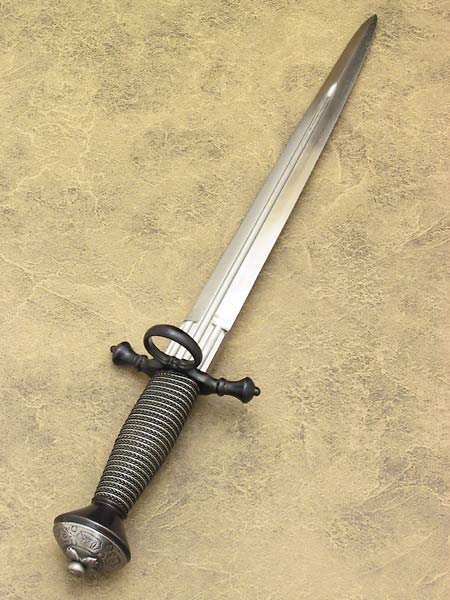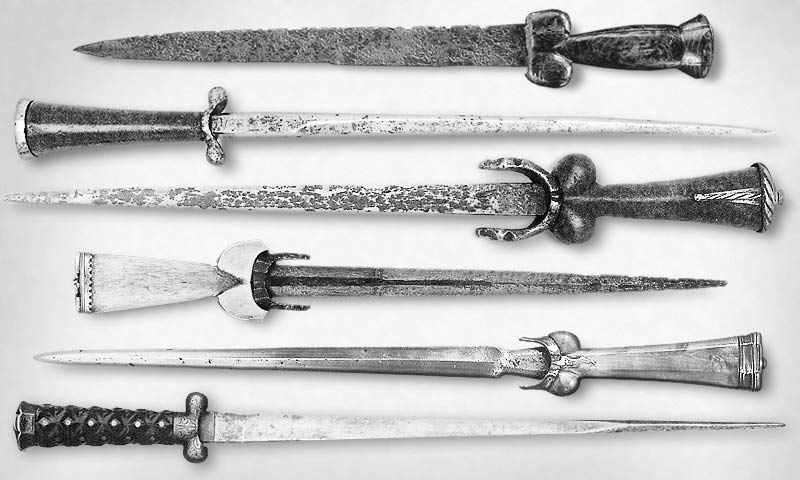
| myArmoury.com is now completely member-supported. Please contribute to our efforts with a donation. Your donations will go towards updating our site, modernizing it, and keeping it viable long-term.
Last 10 Donors: Graham Shearlaw, Anonymous, Daniel Sullivan, Chad Arnow, Jonathan Dean, M. Oroszlany, Sam Arwas, Barry C. Hutchins, Dan Kary, Oskar Gessler (View All Donors) |
| Author |
Message |
|
Carl Goff
|
 Posted: Sat 30 Dec, 2006 11:34 pm Post subject: Say, can anyone post examples of a 16th C. kidney dagger? Posted: Sat 30 Dec, 2006 11:34 pm Post subject: Say, can anyone post examples of a 16th C. kidney dagger? |
 |
|
I was in Charleston, SC, over the holidays, and an antiques shop there had what they claimed were two of those. They looked roughly accurate, but I don't know enough about the stylistic details of that particular weapon type to say for sure.
Examples of jambiyas would be nice, too, as the shop had a very pretty engraved one they said was a more recent (19th century) piece.
Edit: Apparently, they were parrying daggers of some kind, not kidney daggers.
Oh, East of sands and sunlit gulf, your blood is thin, your gods are few;
You could not break the Northern wolf and now the wolf has turned on you.
The fires that light the coasts of Spain fling shadows on the Eastern strand.
Master, your slave has come again with torch and axe in his right hand!
-Robert E. Howard
Last edited by Carl Goff on Sun 31 Dec, 2006 8:00 pm; edited 1 time in total
|
|
  |
 |
Nathan Robinson
myArmoury Admin


|
|
    |
 |
|
Carl Goff
|
 Posted: Sun 31 Dec, 2006 10:19 am Post subject: Posted: Sun 31 Dec, 2006 10:19 am Post subject: |
 |
|
Not quite...they looked more like this A&A parrying dagger, although I think one lacked the ring on the guard. I want to say the blades weren't as wide, either, but that could be my memory playing tricks on me.

The shop claimed Italian provenance for both, if that helps.
Oh, East of sands and sunlit gulf, your blood is thin, your gods are few;
You could not break the Northern wolf and now the wolf has turned on you.
The fires that light the coasts of Spain fling shadows on the Eastern strand.
Master, your slave has come again with torch and axe in his right hand!
-Robert E. Howard
|
|
  |
 |
Chad Arnow
myArmoury Team


|
 Posted: Sun 31 Dec, 2006 11:29 am Post subject: Posted: Sun 31 Dec, 2006 11:29 am Post subject: |
 |
|
| Carl Goff wrote: | Not quite...they looked more like this A&A parrying dagger, although I think one lacked the ring on the guard. I want to say the blades weren't as wide, either, but that could be my memory playing tricks on me.
The shop claimed Italian provenance for both, if that helps. |
Well, if it looked like that parrying dagger then it wasn't a kidney dagger. Kidney dagger=ballock dagger. Here are more ballock daggers, from our Scottish Dirk spotlight.

If it looked like that parrying dagger without the ring, then it's a quiliion dagger/parrying dagger.

ChadA
http://chadarnow.com/
|
|
    |
 |
Nathan Robinson
myArmoury Admin


|
 Posted: Sun 31 Dec, 2006 1:19 pm Post subject: Posted: Sun 31 Dec, 2006 1:19 pm Post subject: |
 |
|
Carl-
A "kidney dagger" is a Victorian name for a Ballock Dagger. The prudish times didn't allow for such a suggestive term so they sought another variation.
The dagger you posted is closer to a Saxon variety, one that is sometimes considered an evolutionary form of Landsknecht dagger.
If the daggers found at the antique store look more like A&A's dagger that you posted, they would more appropriately be called "Saxon Daggers" and are generally very late 16th, early 17th century designs. Please note, however, that A&A's version is not based on anything historical but was created as a companion dagger made to match the Gustav Vasa rapier. Its design is based on historical pieces, but nothing in particular.
When it comes to antique arms, armour, and the like, these antique stores almost never know what they have. The same can often be said about furniture and other things found in such stores. The consumer shopping at antique stores really needs to be informed prior to purchasing a high-ticket item.
.:. Visit my Collection Gallery :: View my Reading List :: View my Wish List :: See Pages I Like :: Find me on Facebook .:.
|
|
    |
 |
|
Carl Goff
|
 Posted: Sun 31 Dec, 2006 7:54 pm Post subject: Posted: Sun 31 Dec, 2006 7:54 pm Post subject: |
 |
|
| Nathan Robinson wrote: | Carl-
A "kidney dagger" is a Victorian name for a Ballock Dagger. The prudish times didn't allow for such a suggestive term so they sought another variation. |
Ahh, thank you. Learn something new every day.
| Quote: | | When it comes to antique arms, armour, and the like, these antique stores almost never know what they have. The same can often be said about furniture and other things found in such stores. The consumer shopping at antique stores really needs to be informed prior to purchasing a high-ticket item. |
Why am I not too surprised? They were inflating the origin of those daggers, by the way. "Used by Borgia assassins," my fat hairy butt!
Shop did have one of those rather charming flintlock pistol/dagger combos, though.
***
Do you want me to change the post title or anything, since it's rather misleading?
Oh, East of sands and sunlit gulf, your blood is thin, your gods are few;
You could not break the Northern wolf and now the wolf has turned on you.
The fires that light the coasts of Spain fling shadows on the Eastern strand.
Master, your slave has come again with torch and axe in his right hand!
-Robert E. Howard
|
|
  |
 |
|
Manouchehr M.
|
|
   |
 |
|
Lafayette C Curtis
|
 Posted: Mon 01 Jan, 2007 10:00 am Post subject: Posted: Mon 01 Jan, 2007 10:00 am Post subject: |
 |
|
|
One-edged European daggers? Definitely! Just check this site's Feature articles on the Scottish dirk and the rondel dagger for some examples.
|
|
  |
 |
|
J. Bedell
|
 Posted: Mon 01 Jan, 2007 10:26 am Post subject: Posted: Mon 01 Jan, 2007 10:26 am Post subject: |
 |
|
Lafayette,
I'm not sure but I think Manouchehr was looking for single edged ballock daggers specifically.
-James
The pen may be mighter, but the sword is much more fun.
|
|
    |
 |
Richard Fay

|
 Posted: Mon 01 Jan, 2007 11:58 am Post subject: Posted: Mon 01 Jan, 2007 11:58 am Post subject: |
 |
|
Hello all!
In The Complete Encyclopedia of Arms & Weapons, edited by Leonid Tarrasuk and Claude Blair, the entry for daggers states that ballock knives or daggers were usually single-edged. Here's the section about ballock knives:
| Tarrasuk & Blair wrote: |
Ballock knife (or kidney dagger). This is the medieval term describing a dagger which has a grip bearing a considerable resemblance to a phallic symbol. From the 19th century it has been also called "kidney dagger". At the base of the grip there are two roundish, symmetrical globes, with the grip itself emerging upward between then and flaring slightly toward the top, sometimes surmounted by a cap. The narrow, strong blade was usually single-edged and often spurred or reinforced at the tip. It is depicted iconographically from the early 14th century onward as a weapon used by knights and soldiers but later also by citizens and country folk. It remained in vogue until the 17th century; in England and the Netherlands it remained in use until the early 19th century, and it probably was a prototype of the Scottish dirk. |
Blair shows a photo of the remains of a ballock knife in plate 183 in European & American Arms. The remainder of the blade clearly has a thick spine on the back edge; it was single-edged for at least part of the blade.
Ewart Oakeshott also talks about single-edged, or more precisely back-edged, blades on ballock daggers in A Knight and His Weapons:
| Ewart Oakeshott wrote: |
generally the blade was back-edged, though there are many double-edged examples. |
So, there seems to have been single-edged ballock daggers.
I hope this helped!
"I'm going to do what the warriors of old did! I'm going to recite poetry!"
Prince Andrew of Armar
|
|
 |
 |
|
Manouchehr M.
|
|
   |
 |
|
|
You cannot post new topics in this forum
You cannot reply to topics in this forum
You cannot edit your posts in this forum
You cannot delete your posts in this forum
You cannot vote in polls in this forum
You cannot attach files in this forum
You can download files in this forum
|
All contents © Copyright 2003-2025 myArmoury.com — All rights reserved
Discussion forums powered by phpBB © The phpBB Group
Switch to the Basic Low-bandwidth Version of the forum
|

